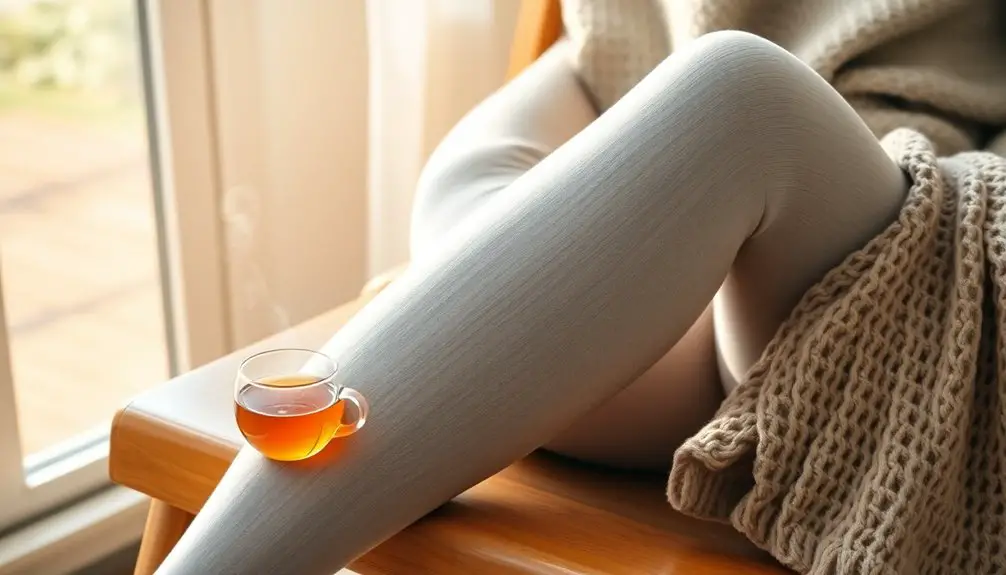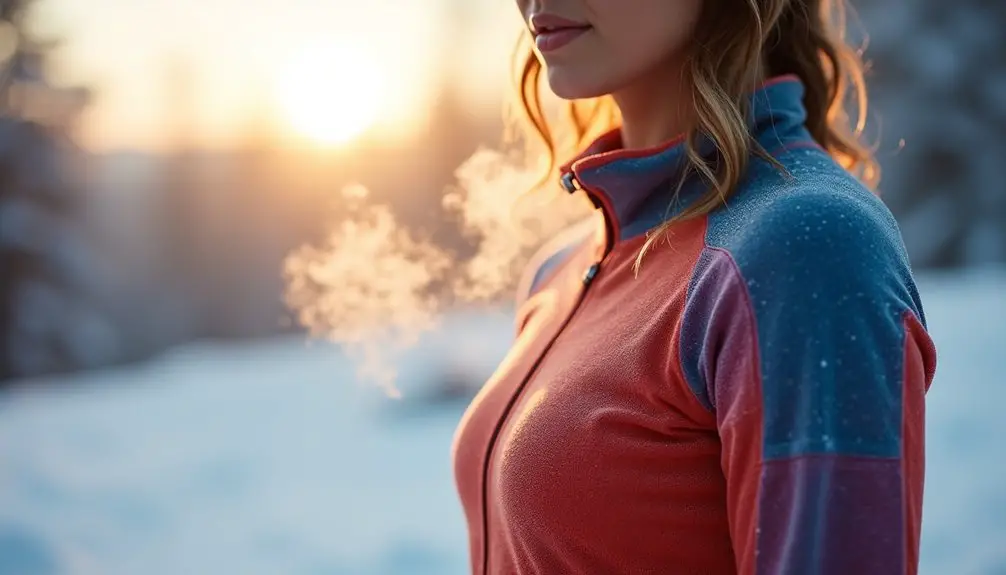Yes, polypropylene thermals are great for keeping you warm and comfortable in cold weather. They excel in moisture-wicking, ensuring you stay dry and warm during outdoor activities. Lightweight yet effective, they trap body heat without bulk. You'll also find them quick to dry, which helps maintain warmth even if they get wet. Their breathability allows air to circulate, preventing overheating. However, they may not be as odor-resistant as some alternatives. Overall, if you're looking for a reliable base layer, polypropylene is a solid option. There's more to uncover about their advantages and care tips.
Key Takeaways
- Polypropylene thermals provide excellent moisture-wicking, keeping you dry and warm during cold conditions.
- They are lightweight and quick-drying, ensuring comfort and preventing prolonged dampness.
- While they excel in moisture management, polypropylene lacks the natural temperature regulation of materials like Merino wool.
- Breathability is good, allowing air flow, but they are not windproof, which may limit effectiveness in extreme conditions.
- Overall comfort is high due to their soft texture, making them suitable for extended wear in winter activities.
Importance of Thermal Underwear
When the temperature drops, thermal underwear becomes your first line of defense against the cold. It's an important piece of clothing, especially for outdoor activities in winter.
Designed to trap body heat, thermal underwear prevents rapid heat loss, ensuring you stay warm even in harsh conditions. Its moisture-wicking capabilities create a microclimate of warmth close to your skin, reducing the risk of hypothermia and frostbite during prolonged exposure.
Materials like Merino Wool offer exceptional warmth and breathability, making them ideal for winter adventures. The snug fit is crucial for optimal insulation and moisture management, allowing you to move freely while keeping you warm.
Whether you're skiing, hiking, or simply enjoying a winter stroll, a quality pair of thermal underwear will enhance your comfort and performance.
Investing in thermal underwear is vital—cheaper options often lack durability and the long-term value you need for consistent protection.
By choosing well-made thermal wear, you're not just investing in clothing; you're ensuring your safety and comfort in cold environments.
Prioritize quality, and you'll appreciate the benefits when the temperature really drops.
Additionally, thermal underwear can be layered under clothing to mimic the microclimate effect created by greenhouses, trapping warm air close to the skin for enhanced insulation.
Characteristics of Polypropylene
What makes polypropylene an excellent choice for thermal wear? Its unique characteristics provide a perfect balance of warmth, comfort, and performance, especially in challenging weather conditions. Polypropylene is also a low-density thermoplastic, which contributes to its lightweight design and exceptional warmth-to-weight ratio, ensuring you stay warm without feeling bulky.
- Moisture-wicking: Polypropylene doesn't absorb water, helping you stay dry and warm even when wet.
- Soft and comfortable: The fabric feels great against your skin, making it ideal for long wear.
- Breathability: While it allows air passage, it's not windproof, so you can enjoy comfort during physical activities without overheating.
- Dry quickly: This material dries much faster than cotton, so you won't be left in damp clothing.
- Minimal odor retention: You'll find that these thermals require infrequent washing, perfect for extended outdoor adventures.
With these features, polypropylene thermals effectively combine warmth, breathability, and practicality, making them a smart choice for your thermal wear needs.
Whether you're hiking, skiing, or just enjoying the outdoors, you'll feel comfortable and protected.
Comparing Polypropylene and Merino Wool

In the realm of thermal wear, polypropylene and merino wool present distinct advantages tailored to different needs. If you're looking for a base layer that excels in moisture management, polypropylene is your go-to. It quickly wicks away moisture, dries fast, and retains less odor, but can also be used in products like food-safe containers due to its safe and non-toxic properties. However, merino wool shines when it comes to natural temperature regulation and comfort against the skin.
| Feature | Polypropylene | Merino Wool |
|---|---|---|
| Moisture Management | Excellent moisture-wicking | Absorbs moisture, slower drying |
| Warmth-to-Weight Ratio | Lightweight, highly effective | Bulkier, but warm |
| Durability | Highly durable, withstands washing | Prone to holes if not cared for |
| Odor Resistance | May retain odors over time | Naturally odor-resistant |
| Temperature Regulation | Requires snug fit for best performance | Naturally regulates temperature |
Ultimately, your choice between polypropylene and merino wool will depend on your specific needs regarding body heat retention, comfort, and care preferences. Each material has unique strengths that cater to various activities and environments.
Performance Features to Consider
Choosing the right polypropylene thermals means considering several key performance features that can enhance your outdoor experience. Understanding these attributes will help you enjoy optimal comfort and warmth during your adventures.
- Warmth-to-Weight Ratio: Polypropylene thermals are lightweight (around 100 grams) yet provide significant insulation.
- Moisture Management: They effectively wick moisture away from your skin, keeping you dry and comfortable.
- Breathability: These thermals allow for excellent airflow, helping to regulate your body temperature during intense activities.
- Compatibility with Different Materials: Since they're not windproof, pair them with an effective outer layer for added protection against harsh winds.
- Quick Drying: Unlike cotton, polypropylene doesn't absorb water, allowing it to dry rapidly while maintaining warmth.
- Additionally, the inherent chemical resistance of polypropylene materials contributes to their durability, making them a suitable choice for active outdoor enthusiasts who need thermals that can withstand various environmental conditions.
Care and Maintenance Tips

Proper care and maintenance are essential for maximizing the lifespan and performance of your polypropylene thermals. To keep their moisture-wicking properties intact, wash them in cold or lukewarm water using a mild detergent. Avoid fabric softeners, as they can coat the fibers and reduce the thermals' effectiveness in moisture management.
For drying, air drying is recommended to prevent shrinkage and maintain the garment's shape. If you choose to use a dryer, select a low heat or delicate cycle setting to minimize damage.
Before storing your thermals, ensure they're completely clean and dry to avoid any moisture buildup. Use breathable storage containers instead of plastic bags, which can trap moisture and lead to mildew. This is especially important for extending the lifespan of your thermals, much like how poly lumber is durable and rot-resistant due to its high-density recycled plastic construction.
Regularly inspect your thermals for signs of wear or damage, especially if you've used them in rugged outdoor conditions. Addressing issues early helps maintain their warmth and breathability.
Frequently Asked Questions
Is Polypropylene Good for Thermals?
Polypropylene's great for thermals because it effectively wicks moisture away, keeping you dry. Its lightweight design offers excellent warmth without bulk, and it dries quickly, making it a practical choice for various outdoor activities.
What Type of Thermals Are the Warmest?
When you're looking for the warmest thermals, consider those made from polypropylene. They trap air effectively, offer excellent moisture management, and keep you cozy even in damp conditions, making them perfect for cold outdoor activities.
Is Polypropylene a Breathable Material?
Yes, polypropylene is a breathable material. It allows air to pass through while trapping warmth, keeping you comfortable. Its lightweight design and quick-drying properties make it ideal for layering during outdoor activities without retaining moisture.
Which Is Warmer, Polypropylene or Polyester?
Polypropylene's warmer than polyester due to its superior warmth-to-weight ratio and hollow fiber structure, which traps more air. You'll stay warmer, especially in wet conditions, as it doesn't absorb moisture like polyester does.

